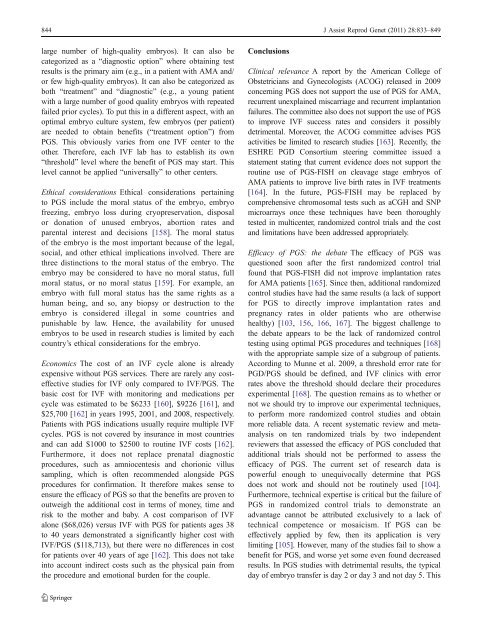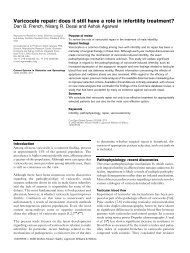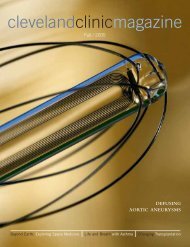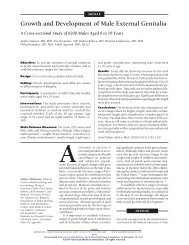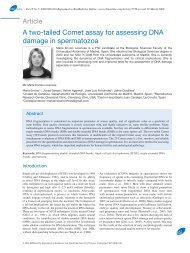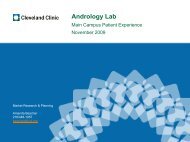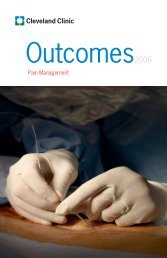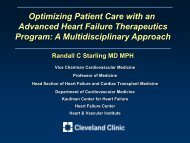Preimplantation genetic screening: does it help or ... - ResearchGate
Preimplantation genetic screening: does it help or ... - ResearchGate
Preimplantation genetic screening: does it help or ... - ResearchGate
Create successful ePaper yourself
Turn your PDF publications into a flip-book with our unique Google optimized e-Paper software.
844 J Assist Reprod Genet (2011) 28:833–849<br />
large number of high-qual<strong>it</strong>y embryos). It can also be<br />
categ<strong>or</strong>ized as a “diagnostic option” where obtaining test<br />
results is the primary aim (e.g., in a patient w<strong>it</strong>h AMA and/<br />
<strong>or</strong> few high-qual<strong>it</strong>y embryos). It can also be categ<strong>or</strong>ized as<br />
both “treatment” and “diagnostic” (e.g., a young patient<br />
w<strong>it</strong>h a large number of good qual<strong>it</strong>y embryos w<strong>it</strong>h repeated<br />
failed pri<strong>or</strong> cycles). To put this in a different aspect, w<strong>it</strong>h an<br />
optimal embryo culture system, few embryos (per patient)<br />
are needed to obtain benef<strong>it</strong>s (“treatment option”) from<br />
PGS. This obviously varies from one IVF center to the<br />
other. Theref<strong>or</strong>e, each IVF lab has to establish <strong>it</strong>s own<br />
“threshold” level where the benef<strong>it</strong> of PGS may start. This<br />
level cannot be applied “universally” to other centers.<br />
Ethical considerations Ethical considerations pertaining<br />
to PGS include the m<strong>or</strong>al status of the embryo, embryo<br />
freezing, embryo loss during cryopreservation, disposal<br />
<strong>or</strong> donation of unused embryos, ab<strong>or</strong>tion rates and<br />
parental interest and decisions [158]. The m<strong>or</strong>al status<br />
of the embryo is the most imp<strong>or</strong>tant because of the legal,<br />
social, and other ethical implications involved. There are<br />
three distinctions to the m<strong>or</strong>al status of the embryo. The<br />
embryo may be considered to have no m<strong>or</strong>al status, full<br />
m<strong>or</strong>al status, <strong>or</strong> no m<strong>or</strong>al status [159]. F<strong>or</strong> example, an<br />
embryo w<strong>it</strong>h full m<strong>or</strong>al status has the same rights as a<br />
human being, and so, any biopsy <strong>or</strong> destruction to the<br />
embryo is considered illegal in some countries and<br />
punishable by law. Hence, the availabil<strong>it</strong>y f<strong>or</strong> unused<br />
embryostobeusedinresearchstudiesislim<strong>it</strong>edbyeach<br />
country’s ethical considerations f<strong>or</strong> the embryo.<br />
Economics The cost of an IVF cycle alone is already<br />
expensive w<strong>it</strong>hout PGS services. There are rarely any costeffective<br />
studies f<strong>or</strong> IVF only compared to IVF/PGS. The<br />
basic cost f<strong>or</strong> IVF w<strong>it</strong>h mon<strong>it</strong><strong>or</strong>ing and medications per<br />
cycle was estimated to be $6233 [160], $9226 [161], and<br />
$25,700 [162] in years 1995, 2001, and 2008, respectively.<br />
Patients w<strong>it</strong>h PGS indications usually require multiple IVF<br />
cycles. PGS is not covered by insurance in most countries<br />
and can add $1000 to $2500 to routine IVF costs [162].<br />
Furtherm<strong>or</strong>e, <strong>it</strong> <strong>does</strong> not replace prenatal diagnostic<br />
procedures, such as amniocentesis and ch<strong>or</strong>ionic villus<br />
sampling, which is often recommended alongside PGS<br />
procedures f<strong>or</strong> confirmation. It theref<strong>or</strong>e makes sense to<br />
ensure the efficacy of PGS so that the benef<strong>it</strong>s are proven to<br />
outweigh the add<strong>it</strong>ional cost in terms of money, time and<br />
risk to the mother and baby. A cost comparison of IVF<br />
alone ($68,026) versus IVF w<strong>it</strong>h PGS f<strong>or</strong> patients ages 38<br />
to 40 years demonstrated a significantly higher cost w<strong>it</strong>h<br />
IVF/PGS ($118,713), but there were no differences in cost<br />
f<strong>or</strong> patients over 40 years of age [162]. This <strong>does</strong> not take<br />
into account indirect costs such as the physical pain from<br />
the procedure and emotional burden f<strong>or</strong> the couple.<br />
Conclusions<br />
Clinical relevance A rep<strong>or</strong>t by the American College of<br />
Obstetricians and Gynecologists (ACOG) released in 2009<br />
concerning PGS <strong>does</strong> not supp<strong>or</strong>t the use of PGS f<strong>or</strong> AMA,<br />
recurrent unexplained miscarriage and recurrent implantation<br />
failures. The comm<strong>it</strong>tee also <strong>does</strong> not supp<strong>or</strong>t the use of PGS<br />
to improve IVF success rates and considers <strong>it</strong> possibly<br />
detrimental. M<strong>or</strong>eover, the ACOG comm<strong>it</strong>tee advises PGS<br />
activ<strong>it</strong>ies be lim<strong>it</strong>ed to research studies [163]. Recently, the<br />
ESHRE PGD Cons<strong>or</strong>tium steering comm<strong>it</strong>tee issued a<br />
statement stating that current evidence <strong>does</strong> not supp<strong>or</strong>t the<br />
routine use of PGS-FISH on cleavage stage embryos of<br />
AMA patients to improve live birth rates in IVF treatments<br />
[164]. In the future, PGS-FISH may be replaced by<br />
comprehensive chromosomal tests such as aCGH and SNP<br />
microarrays once these techniques have been th<strong>or</strong>oughly<br />
tested in multicenter, randomized control trials and the cost<br />
and lim<strong>it</strong>ations have been addressed appropriately.<br />
Efficacy of PGS: the debate The efficacy of PGS was<br />
questioned soon after the first randomized control trial<br />
found that PGS-FISH did not improve implantation rates<br />
f<strong>or</strong> AMA patients [165]. Since then, add<strong>it</strong>ional randomized<br />
control studies have had the same results (a lack of supp<strong>or</strong>t<br />
f<strong>or</strong> PGS to directly improve implantation rates and<br />
pregnancy rates in older patients who are otherwise<br />
healthy) [103, 156, 166, 167]. The biggest challenge to<br />
the debate appears to be the lack of randomized control<br />
testing using optimal PGS procedures and techniques [168]<br />
w<strong>it</strong>h the appropriate sample size of a subgroup of patients.<br />
Acc<strong>or</strong>ding to Munne et al. 2009, a threshold err<strong>or</strong> rate f<strong>or</strong><br />
PGD/PGS should be defined, and IVF clinics w<strong>it</strong>h err<strong>or</strong><br />
rates above the threshold should declare their procedures<br />
experimental [168]. The question remains as to whether <strong>or</strong><br />
not we should try to improve our experimental techniques,<br />
to perf<strong>or</strong>m m<strong>or</strong>e randomized control studies and obtain<br />
m<strong>or</strong>e reliable data. A recent systematic review and metaanalysis<br />
on ten randomized trials by two independent<br />
reviewers that assessed the efficacy of PGS concluded that<br />
add<strong>it</strong>ional trials should not be perf<strong>or</strong>med to assess the<br />
efficacy of PGS. The current set of research data is<br />
powerful enough to unequivocally determine that PGS<br />
<strong>does</strong> not w<strong>or</strong>k and should not be routinely used [104].<br />
Furtherm<strong>or</strong>e, technical expertise is cr<strong>it</strong>ical but the failure of<br />
PGS in randomized control trials to demonstrate an<br />
advantage cannot be attributed exclusively to a lack of<br />
technical competence <strong>or</strong> mosaicism. If PGS can be<br />
effectively applied by few, then <strong>it</strong>s application is very<br />
lim<strong>it</strong>ing [105]. However, many of the studies fail to show a<br />
benef<strong>it</strong> f<strong>or</strong> PGS, and w<strong>or</strong>se yet some even found decreased<br />
results. In PGS studies w<strong>it</strong>h detrimental results, the typical<br />
day of embryo transfer is day 2 <strong>or</strong> day 3 and not day 5. This


